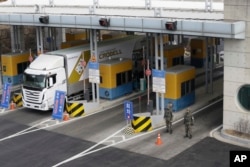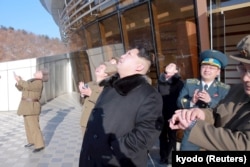South Korean President Park Geun-hye will defend her hardline response to North Korea’s recent nuclear test and rocket launch in an address to the National Assembly in Seoul Tuesday.
Following North Korea’s recent moves, Park has abandoned virtually any hope of negotiating with the Kim Jong Un government and has joined with allies Washington and Tokyo to step up efforts to coerce Pyongyang to capitulate.
“It is clear that the music has stopped for the Park Geun-hye administration and it shows the intention that it is no longer interested in doing any kind of dancing with the North Korean authorities,” said Bong Young-shik, a national security analyst with the Asan Institute for Policy Studies in Seoul.
Halting cash flows
Sunday the Park administration justified closing the jointly run Kaesong Industrial Complex in North Korea last week, saying that 70 percent of the income generated at the complex was used to finance the North’s nuclear program.
The United Nations has banned North Korea from developing nuclear weapons and ballistic missile technology and has imposed four rounds of increasingly stronger sanctions since 2006.
After North Korea’s third nuclear test in 2013, the U.N. imposed sanctions prohibiting the bulk transfers of cash that could be linked to illicit activities by the North.
In an interview with South Korean broadcaster KBS Sunday, Unification Minister Hong Yong-pyo said the salaries of the 54,000 North Korean workers, and other costs associated with running the Kaesong complex, were transferred in U.S. dollars directly to a North Korean government bureau called Office 39.
He said this bureau, which is run by the ruling Worker’s Party, manages all foreign currency transfers. And in the case of Kaesong, it funneled 70 percent of the approximately $120 million in earnings each year to the military and other prohibited programs.
In closing the Kaesong complex, the Park administration ended the last significant cooperative inter-Korean project, initiated over a decade ago to build trust and reduce the potential for conflict between these long-term enemies.
Other South Korean aid programs were halted and sanctions imposed against North Korea in 2010, after Seoul accused Pyongyang of sinking a South Korean warship and killing 46 sailors.
Turning from China
Seoul has moved closer to Washington with its decision to proceed with formal talks to deploy the controversial Terminal High-Altitude Area Defense (THAAD) missile defense system.
Although there were reports in the past year that Seoul was quietly considering THAAD, President Park had been reluctant to endorse it, reportedly to maintain good relations with Chinese President Xi Jinping.
The two leaders had pushed closer economic and diplomatic ties over the last few years. China is now South Korea’s biggest trading partner. The trade volume between the two Asian neighbors, over $200 billion, is more than double the volume between South Korea and the U.S.
President Park has also visited China numerous times, most recently attending celebrations in Beijing for the 70th anniversary of the end of World War II. Kim Jong Un has yet to meet with the Chinese President.
China and Russia oppose stationing THAAD in Korea because it could further fuel a regional arms race and because the over 1,000-kilometer reach of the system's radar can potentially be used to monitor military installations in their countries.
Beijing has called on all sides involved in the tensions on the Korean peninsula to practice restraint.
However, North Korea’s recent provocations, analysts say, gave the conservative South Korean leader the justification she had been seeking to support increased military measures.
“Now this is a moment where essentially the two sides can use a palpable North Korean threat to say, ‘okay let’s really bring this front and center into the public eye and move ahead,’” said analyst John Delury, with Yonsei University in Seoul.
Regime change
In the National Assembly, some members of Park’s ruling Saenuri party have called for even stronger security measures.
On Monday Won Yoo-cheol, a party leader in the legislature, called for South Korea to deploy its own nuclear deterrent or again station U.S. tactical nuclear weapons. The U.S. pulled its tactical nuclear weapons out of South Korea in 1991.
And Na Kyung-won, the chairwoman of South Korea's parliamentary committee on foreign affairs said Monday that it is now time to consider a regime change in North Korea.
The Park administration rejected these options as too extreme, but analyst Bong Young-shik, with the Asan Institute for Policy Studies, would like the South Korean president to say in her speech Tuesday if the goal of increased sanctions is to collapse the Kim Jong Un government and at what cost.
“I hope that her address would include a very specific and persuasive explanation on why purely coercive measures should have been taken and why we need to believe that, despite all these concerning aspects of the strategy, the strategy will eventually work,” said Bong Young-shik,
Washington and Beijing are still reportedly at odds over imposing strong United Nations sanctions, with China saying it does not want to trigger regional instability.
Analysts say that unless China’s goes along with proposed measures to cut off trade and aid to its ally, sanctions will have a very limited impact.


